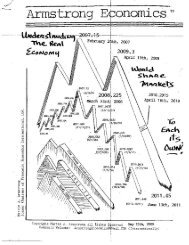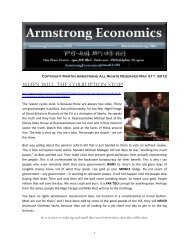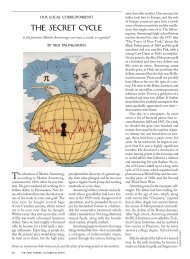1998 Fall Tour Seminar - Martin Armstrong
1998 Fall Tour Seminar - Martin Armstrong
1998 Fall Tour Seminar - Martin Armstrong
Create successful ePaper yourself
Turn your PDF publications into a flip-book with our unique Google optimized e-Paper software.
Princeton Economics<br />
International<br />
<strong>1998</strong><br />
<strong>Fall</strong> <strong>Tour</strong>
Economic Confidence Model tm<br />
Defining the global business cycle<br />
Success of PEI Global Market Approach<br />
July 20th, <strong>1998</strong><br />
April 1st, 1994<br />
Dec 29th, 1989<br />
October 19th, 1987<br />
August 1985
Economic Confidence Model tm<br />
Defining the global business cycle
Economic Confidence Model tm<br />
Defining the global business cycle
Economic Confidence Model tm<br />
Defining the global business cycle
Economic Confidence Model tm<br />
Defining the global business cycle
Economic Confidence Model tm<br />
Defining the global business cycle
Economic Confidence Model tm<br />
Defining the global business cycle
Economic Confidence Model tm<br />
Defining the global business cycle
Economic Confidence Model tm<br />
Defining the global business cycle
Economic Confidence Model<br />
tm<br />
Defining the global business cycle
Economic Confidence Model<br />
Back Testing<br />
through History<br />
tm<br />
Defining the global business cycle
Economic Confidence Model tm<br />
Defining the global business cycle
Economic Confidence Model tm<br />
Defining the global business cycle
Economic Confidence Model tm<br />
Defining the global business cycle
Economic Confidence Model tm<br />
Defining the global business cycle
Economic Confidence Model tm<br />
Defining the global business cycle
Economic Confidence Model tm<br />
Defining the global business cycle
Economic Confidence Model tm<br />
Defining the global business cycle
Economic Confidence Model tm<br />
US 1929<br />
Bubble Top<br />
Defining the global business cycle<br />
Period Doubling<br />
Effect of last 2 years<br />
sign of a Bubble Top
Economic Confidence Model tm<br />
Period Doubling<br />
Effect of last 2 years<br />
sign of a Bubble Top<br />
Defining the global business cycle<br />
Tokyo 1989<br />
Bubble Top
Economic Confidence Model tm<br />
Period Doubling<br />
Effect of last 2 years<br />
sign of a Bubble Top<br />
Defining the global business cycle<br />
US advance was<br />
30% of that in<br />
Europe for 98<br />
European Bubble Top of <strong>1998</strong>
Economic Confidence Model tm<br />
Defining the global business cycle<br />
Today’s problems have<br />
been caused by the<br />
disruption to global<br />
capital flows thanks<br />
to the:<br />
G7<br />
IMF<br />
World Bank<br />
BIS<br />
Euro<br />
Politicians
Economic Confidence Model tm<br />
Defining the global business cycle<br />
After the Plaza Accord in<br />
Sept 1985 & birth of G5,<br />
we warned President Reagan<br />
that G5 would cause a<br />
Crash in 1987 and that<br />
currency manipulation<br />
should not be used to<br />
influence trade.
Economic Confidence Model tm<br />
Defining the global business cycle<br />
The Crash of 1987<br />
was caused by G5<br />
currency<br />
manipulation<br />
that set in motion a<br />
capital repatriation<br />
from Japan that led<br />
to the Bubble Top<br />
formation in 1989 as<br />
foreign capital<br />
concentrated also in<br />
Japan
Economic Confidence Model tm<br />
Defining the global business cycle<br />
87 Crash caused by 40%<br />
decline in US dollar by<br />
G5 which sparked<br />
major selling of $ assets
Economic Confidence Model tm<br />
As capital returned to Japan<br />
Bubble Top form with the<br />
1989.95 turning point<br />
Defining the global business cycle
Economic Confidence Model tm<br />
Defining the global business cycle<br />
Following the<br />
1989.95 turning<br />
point, the next<br />
4.3 year period on<br />
the model marked a<br />
global shift in<br />
capital flows toward<br />
Southeast Asia<br />
in particular. This<br />
flow of capital then<br />
created a Bubble<br />
Top in most of these<br />
markets.
Economic Confidence Model tm<br />
Defining the global business cycle
Economic Confidence Model tm<br />
Defining the global business cycle
Economic Confidence Model tm<br />
Defining the global business cycle<br />
Capital Flows reached<br />
record highs in 1989 for<br />
Indonesia & Taiwan
Economic Confidence Model tm<br />
Defining the global business cycle<br />
With the Mexican<br />
Crisis, Southeast<br />
Asia reached its peak<br />
in 1994 and capital<br />
began to shift back to<br />
the West. It would<br />
also be during this<br />
next wave when<br />
capital flows into<br />
Russia multiplied<br />
thanks to hints of<br />
undying support<br />
from the IMF.
Economic Confidence Model tm<br />
Defining the global business cycle<br />
US market reached<br />
a precise low on<br />
April 1st, 1994 in<br />
conjunction with the<br />
Economic<br />
Confidence Model<br />
Turning Point<br />
1994.25
Economic Confidence Model tm<br />
Defining the global business cycle<br />
12 waves of 8.6 months = 8.6 years
Economic Confidence Model tm<br />
Defining the global business cycle<br />
As the half-cycle<br />
approached on<br />
May 25th, 1996<br />
(1996.4), we at last<br />
achieved a 2 month<br />
correction similar in<br />
timing to that of the<br />
1987 Crash. This<br />
turning point<br />
produced a high and<br />
as such a hint of<br />
what would come on<br />
July 20th, <strong>1998</strong>
Economic Confidence Model tm<br />
Defining the global business cycle<br />
The final period<br />
moving into <strong>1998</strong>.55<br />
(July 20th, <strong>1998</strong>), the<br />
market performed<br />
precisely according<br />
to its 8.6 month<br />
component structure
Economic Confidence Model<br />
tm<br />
Defining the global business cycle<br />
Gov’t Intervention using Interest Rates Never Works
Economic Confidence Model tm<br />
Defining the global business cycle<br />
The volatility in<br />
foreign exchange<br />
will be the driving<br />
force behind the<br />
major capital<br />
flows worldwide<br />
between 1999 and<br />
2016 as we once<br />
again face the<br />
turmoil of Sovereign<br />
Debt Defaults
Economic Confidence Model tm<br />
Defining the global business cycle<br />
Dollar/Yen reached<br />
high in 1995 but the<br />
continued economic<br />
decline for 26 years<br />
from 1989.95<br />
(2015.75) will be<br />
likely unless a Yearend<br />
closing above<br />
144.80 takes place for<br />
<strong>1998</strong> Year-End
Economic Confidence Model tm<br />
Defining the global business cycle<br />
Dollar support<br />
lies at 110, 107 and<br />
103-104<br />
with major<br />
historical support<br />
at 100.83 and a<br />
monthly close below<br />
this will signal a<br />
economic depression<br />
In Japan
Economic Confidence Model tm<br />
Defining the global business cycle<br />
Currency hedging<br />
will be the only<br />
means of<br />
surviving the<br />
Years ahead for<br />
Volatility will rise<br />
with political<br />
mismanagement
Economic Confidence Model tm<br />
Defining the global business cycle<br />
- - - - - - Outlook - - - - - -<br />
<strong>1998</strong> = Collapse of Russia<br />
1999 = Low Gold & Oil<br />
2000 = Technology Bubble<br />
(Like Railroads in 1907)<br />
2002 = Bottom US Share Market<br />
2007 = Real Estate Bubble, Oil hits $100<br />
2009 = Start of Sovereign Debt Crisis<br />
2011-15 = Japan Economic Decline<br />
EURO begins to crack due to debt crisis<br />
2015.75 = Sovereign Debt Big Bang






